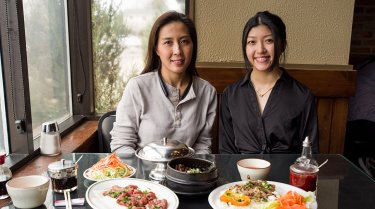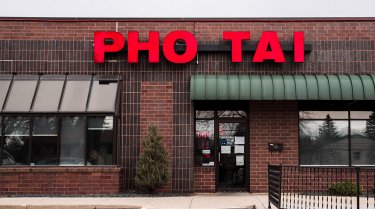Sharing food is a big part of Asian culture. Ann brought the flavors she and her family love from their dinner table to the menu at Pho Tai to share with their customers.
Rice and pork are essential to food culture in Vietnam. Many dishes consists of rice in different forms and all cuts of pork prepared in countless ways.
Banh hoi is thin rice noodles made into small patties for ease of eating. You might enjoy banh hoi by making a wrap with the rice-noodle patties, pieces of lettuce, fresh herbs, pickled vegetables and proteins, and dipping it in nuoc cham, a mixture made with fish sauce, fresh lime juice, garlic and sugar. People in Vietnam often pack or order banh hoi to take to work for lunch, as it’s quick, fresh, filling and healthy. Pho Tai’s version of banh hoi nem nuong is topped with house-made nem nuong, a sweet and savory meatball made with ground pork and a special blend of spices left to marinade and cure before being grilled. To achieve the perfect texture for nem nuong, Ann’s husband grinds the ground pork they use in house every day.
Com tam, suon, bi, cha is a great dish to order if you want to sample multiple dishes at once over broken rice. Broken rice (com tam) is white rice that is fragmented during the milling process. Once upon a time, it was deemed inferior in Vietnam, so it often got separated from the whole grain and was sold more cheaply. It then turned into an economical eat and its own thing. The broken rice has a different texture; it’s a little stickier, chewier, and nuttier, and soaks up sauces more easily than whole-grain rice. Ann often prefers the broken rice over the whole-grain white rice. “There’s just something about it,” she says.
Broken jasmine rice is steamed and served with an array of sides at Pho Tai. The meat pie (cha trung hap) is made with freshly ground pork, glass noodles, wood ear mushrooms and eggs. The meat-pie mixture is steamed, layered with the egg mixture and steamed again. It is savory, flavorful, tender and incredibly moist.
Shredded rind (bi heo) is made with thinly sliced pork rind, marinaded pork slices, garlic, white pepper and most importantly, roasted rice powder. The texture of this dish is unique. If you didn’t know what this is, you might think it’s a cold noodle dish. Bi heo is bouncy and delicately crunchy, with a nutty aroma from the roasted rice powder, which subtly coats your tongue as you chew.
Top-secret spices and a little bit of five-spice powder, soy sauce and fish sauce go into the marinade for Pho Tai’s suon nuong, a pork chop. You’ll find pork chops at almost every Vietnamese restaurant. It is often served with rice or bún, a thin, round rice noodle, along with lettuce, herbs and nuoc cham (dipping sauce). Every restaurant has its signature recipe. The smell of grilled pork chops filling the space is something that’s simply irresistible and sure to make your mouth water.

When asked about the No. 1 tip she would give to people on how to bridge cultures and educate people on them, Ann comments, “Come try our food. Try something you haven’t had before in a relaxed environment. Once you’ve tasted it, hear the stories, you won’t forget it. It all goes hand in hand. You can’t say you don’t like something if you’ve never tried it.”
It’s exciting to see Pho Tai bustling with people of all ethnicities, families, couples and friends, coming together to share a beautiful meal.
“We don’t advertise. It’s all word of mouth,” Ann says. “We’re proud of what we serve at the restaurant.”








